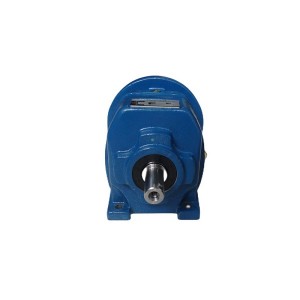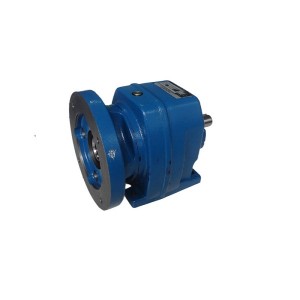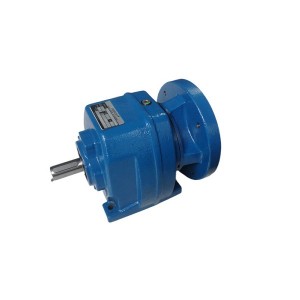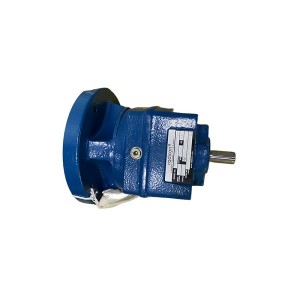In the operation of modern large-scale generator sets, the sealing oil system plays a vital role. Its main function is to provide lubrication for the generator bearings and prevent hydrogen leakage. As an important part of the sealing oil system, the vacuum pump is responsible for extracting the gas in the sealing oil tank, maintaining the negative pressure in the system, and ensuring the effectiveness of the seal. The reliable operation of the vacuum pump is directly related to the safety and stability of the generator set. This article will conduct an in-depth analysis of the overheating failure of the generator sealing oil system vacuum pump reducer model M02225.OBGCC1D1.5A during operation, and explore improvement measures for the lubrication system to improve the operating reliability and service life of the equipment.
As a key component connecting the motor and the vacuum pump, the reducer M02225.OBGCC1D1.5A will generate heat due to the meshing of its internal gears and the operation of the bearings. If the heat cannot be dissipated in a timely and effective manner, it will cause the reducer temperature to rise, that is, an overheating failure will occur. This overheating will not only reduce the lubricating performance of the lubricating oil, accelerate the oxidation and deterioration of the lubricating oil, but also accelerate the wear of parts. In severe cases, it may even cause damage to the reducer, affecting the normal operation of the entire sealing oil system, and thus threatening the safety of the generator set. Therefore, it is of great practical significance to conduct in-depth analysis and improvement of the overheating failure of the vacuum pump reducer.
1. Analysis of the mechanism of overheating failure
The causes of overheating failure of the vacuum pump reducer M02225.OBGCC1D1.5A may involve multiple aspects, among which the lubrication and cooling systems are the key factors affecting its temperature control.

1. Insufficient lubrication:
Lubrication plays a vital role in the reducer M02225.OBGCC1D1.5A. It can not only reduce friction and energy loss, but also take away the heat generated by friction. Insufficient lubrication may be manifested as insufficient oil (or grease), deterioration of oil quality, blockage of lubricating oil circuit or improper filling of grease.
Insufficient oil: If the amount of lubricating oil in the reducer is lower than the design requirements, it will not be able to form an effective lubricating oil film on the surface of the gears and bearings, resulting in an increase in the friction coefficient and friction heat, thereby causing overheating.
Deterioration of oil quality: During long-term operation or in high-temperature environments, the lubricating oil will oxidize and deteriorate, and its viscosity and lubricating properties will decrease, and it will not be able to provide sufficient lubrication protection, resulting in increased friction and weakened heat dissipation capacity.
Blockage of lubricating oil circuit: For reducers with oil lubrication, if the lubricating oil circuit is blocked, the lubricating oil will not be able to reach the parts that need lubrication smoothly, resulting in insufficient local lubrication and high temperature.
Improper grease filling: For reducers with grease lubrication, if the grease is filled too much or too little, or the quality of the grease does not meet the requirements, it may cause poor lubrication and overheating.
2. Failure of the cooling system:
The heat generated by the vacuum pump reducer M02225.OBGCC1D1.5A during operation needs to be dissipated to the environment in time through the cooling system. If the cooling system fails, the heat cannot be effectively discharged, which will cause the reducer temperature to continue to rise.

Poor heat dissipation: Insufficient surface area of the reducer housing or heat dissipation device, dust accumulation on the heat sink, and excessively high ambient temperature will affect the heat dissipation effect and cause heat accumulation.
Poor circulation of cooling medium: For reducers with coolant circulation, if the coolant flow is insufficient, the pipeline is blocked or the cooling pump fails, the cooling effect will be reduced.
Degradation of cooling medium performance: Degradation of coolant performance, such as inappropriate antifreeze concentration or coolant deterioration, will also affect its heat absorption and heat dissipation capabilities.
2. Lubrication system improvement strategy
For the lubrication reasons of reducer overheating failure, the following improvement strategies can be adopted:

1. Grease selection:
Choose the right type of grease: According to the operating temperature, speed, load and other conditions of the reducer M02225.OBGCC1D1.5A, choose grease with good high temperature performance, anti-oxidation performance and load-bearing capacity. For example, in high temperature environments, you can consider using synthetic grease, which has a longer service life and better lubrication performance.
Consider the viscosity of the grease: Reasonably select the viscosity of the grease to ensure that an effective lubricating oil film can be formed at the operating temperature, which can provide sufficient lubrication without increasing friction resistance due to excessive viscosity.
2. Lubrication method optimization:
Improve the grease filling method: Fill the grease strictly according to the recommendations of the reducer manufacturer to avoid overfilling or underfilling. For reducers that need to be regularly replenished with grease, a standardized replenishment cycle and method should be established.
Use a forced lubrication system: For large or critical reducers, you can consider using a forced lubrication system to deliver lubricating oil to each lubrication point through an oil pump to ensure the timeliness and uniformity of lubrication and improve the heat dissipation effect.
3. Lubrication cycle management:
Establish a standardized lubrication cycle: According to the working environment and operating conditions of the reducer M02225.OBGCC1D1.5A, formulate a reasonable grease replacement or replenishment cycle and strictly implement it.
Strengthen the monitoring of lubricant (grease) status: Regularly sample and analyze the lubricant (grease), monitor its viscosity, acid value, wear particles and other indicators, and promptly detect the deterioration of the lubricant (grease) and replace it.

3. Comprehensive maintenance
In addition to targeted lubrication system improvements, strengthening daily maintenance and adopting advanced monitoring technology are crucial to preventing and timely detecting overheating failures of reducer M02225.OBGCC1D1.5A.
1. Preventive maintenance:
Establish a complete maintenance plan: Develop a detailed reducer maintenance plan, including regular inspections, grease replacement, fastener inspections, etc.
Strengthen daily inspections: Strengthen daily inspections of vacuum pump reducers, regularly check their operating sound, vibration, temperature, etc., and detect abnormalities in a timely manner.
2. Intelligent monitoring:
Install temperature monitoring devices: Install temperature sensors at key parts of reducer M02225.OBGCC1D1.5A to monitor the operating temperature of the reducer in real time, and alarm in time when the temperature exceeds the set value.
Use vibration analysis technology: Regular vibration analysis can detect abnormal wear or failures inside the reducer early, thereby avoiding problems such as overheating.
Overheating failure of vacuum pump reducer M02225.OBGCC1D1.5A is a common problem that affects the reliable operation of equipment. Through in-depth analysis and targeted improvement of the lubrication and cooling systems, the operating temperature of the reducer can be effectively reduced, its service life can be extended, and the operating reliability of the equipment can be improved. Selecting appropriate grease, optimizing lubrication methods and cycles, improving heat dissipation conditions, strengthening daily maintenance and adopting advanced monitoring technology are effective ways to solve such problems.
When looking for high-quality, reliable bladder accumulators, YOYIK is undoubtedly a choice worth considering. The company specializes in providing a variety of power equipment including steam turbine accessories, and has won wide acclaim for its high-quality products and services. For more information or inquiries, please contact the customer service below:
E-mail: sales@yoyik.com
Tel: +86-838-2226655
Whatsapp: +86-13618105229
Yoyik offers various types of spare parts for steam turbines, generators, boilers in power plants:
solenoid control valve 54292023
high pressure hoses 45III-1000
Pump DM6D3PB
ball valve 23D-63B
Check valve H61Y-64I
Stop valve J61Y-P5540P
Vane Pump V20-1P8P-1C11
Check valve H42W-10P
Butterfly valve D371X-10C
Check valve H67Y-2850LB SA-182 F91
solenoid coil DG4V3UC60
Drain Valve M-3SEW 6U37/420MG24N9K4V
Pneumatic control valve XL2400-64K
Throttle valve L61Y-P54.5150P 12Cr18Ni9
Stop valve J61Y-32 SA-105
Stop valve J61Y-200V
tube cooler GLC3-4/1.6
oil pump 80LY-80
Reheater inlet plugging valve SD61H-P36.562 SA106-C
Superheater plug valve SD61H-P54160V ZG15Cr1Mo1V
hydraulic globe valve WJ40F1.6P
Instrument valve J21H-2600SPL
Butterfly valve D41W-5JC
Stop valve J61Y-300SPL
Instrument valve J61Y-P55150V 12Cr1MoV
Moog valve D633-303B
types of gearbox M02225.OBGCC1D1.5A
Stop valve J41H-16P
Rotork Gear SH140011
VALVE Q641F-16C DN25
Stop valve J61Y-P55195I
Recycling pump repair kit HSNH-280-43NZ
Vacuum Gate Valve DKZ41Y-25C
Solenoid valve body J-110VDC-DN6-DOF
Post time: Mar-26-2025













